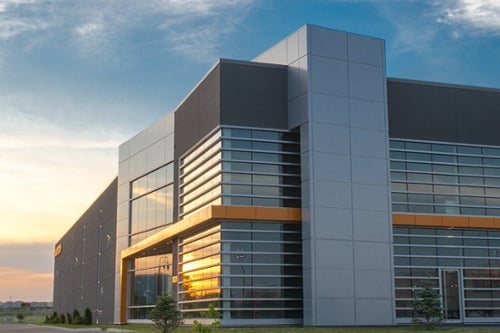Strategic budgeting is key to keeping your warehouse operations running smoothly, and one crucial piece of the puzzle is managing pallet rack maintenance expenses. But where do you draw the line between ongoing costs and long-term investments?
This article will help you understand the difference between CapEx (Capital Expenditure) and OpEx (Operational Expenditure), specifically when it comes to warehouse racking. We’ll break down the distinctions, explore spending options, and equip you to make informed decisions for your budget allocation strategy.
Distinguishing Between Capital and Operating Expenditure
CapEx and OpEx are two categories of financial spending that can be used to manage financial resources.

What does CapEx mean?
Capital expenses occur when a company invests in long-term assets or improvements expected to benefit the business over time. These include property, equipment, machinery, and infrastructure. You might call them capital investment, capital expense, or capital improvement. They include:
- Expenses incurred by a company to acquire, upgrade, or maintain physical assets such as vehicles, equipment, or machines.
- Typically large expenses, one-time investments that provide long-term benefits to the company.
- Examples include purchasing machinery for manufacturing, buying or constructing a new building, investing in technology infrastructure, or acquiring vehicles for transportation.
- Usually recorded on the balance sheet as a capitalized asset and gradually amortized over several years, meaning its value is gradually expensed over its useful life. Some CapEx, such as land, is not depreciated.
What is OpEx?
Operational expenditures cover day-to-day business expenses necessary for running a business. These immediate and recurring costs include salaries, utilities, rent, equipment maintenance, insurance, security, cleaning, and supplies and reflect the ongoing costs necessary to maintain and support a business’s operational activities.
- Day-to-day operational expenses that a company incurs to maintain its regular business operations.
- Typically recurring expenses, necessary for the ongoing functioning of the business.
- Examples include salaries and wages, rent, utilities, office supplies, marketing expenses, and insurance premiums.
- Recorded on the income statement as expenses and deducted from revenue in the period they are incurred. OpEx is not depreciated over its useful life and is recognized right away.
Understanding Capital and Operational Expenses for Warehouse Racking
Not sure if your warehouse rack expenses fall under CapEx or OpEx? It’s a common question, and understanding the difference is crucial for smart budgeting. Here’s a simple breakdown to help you categorize these costs effectively:
CapEx for long-term rack investments
Suppose the spending is related to significant structural improvements or enhancements to the pallet rack systems that provide long-term benefits and increase the overall capacity or efficiency of the warehouse. In that case, it may be considered a capital expenditure.
CapEx must yield returns on investment (ROI), enhance productivity, improve efficiency, and present opportunities for increased revenue.
Rack installations, modifications, or upgrades
The associated costs are considered capital expenditures when installing new pallet racks or upgrading existing ones to enhance safety or comply with new safety regulations or standards.
These significant enhancements or improvements contribute to the rack system’s and warehouse’s long-term capacity and functionality. Investments in rack protection units or engineered rack repair kits have a long-term impact on the safety and integrity of your warehouse and can be accounted as CapEx.
Technological advancements
Technological advancements in rack systems, such as integrating advanced safety monitoring devices or automated inventory management systems, often represent significant long-term investments and need to generate buy-in. These long-lasting safety technologies or systems usually come with up-front costs and are designed to enhance the overall efficiency, safety, and productivity of warehouse operations for an extended period.
Technological upgrades represent a strategic decision with a profound impact on the company’s operational processes and competitive positioning.
Structural enhancements
Investments in structural upgrades are typically treated as CapEx due to their lasting impact on the facility. These improvements can boost the warehouse’s storage capacity, durability, and structural integrity, leading to longer-lasting and better-performing racks. They go beyond routine maintenance and aim to provide long-lasting benefits to the warehouse’s storage capabilities.
OpEx for routine maintenance and recurring expenses
For pallet rack systems, ongoing costs directly tied to the system’s daily maintenance and upkeep are generally accounted as OpEx.
Understanding how to allocate these often recurring costs is key. Strategic planning will help build a budget tailored to your warehouse needs.
Purchase of safety equipment
Safety equipment, such as personal protective equipment (PPE), tools for routine rack maintenance, or safety signage, generally fall under the OpEx category due to its short lifespan and the recurring nature of the expense. It is essential for ensuring the ongoing safety of employees and compliance with safety regulations.
When safety equipment is purchased, the cost is immediately deducted from the company’s revenue in the same accounting period.
Inspections
Routine inspections and maintenance activities generally fall under operational expenditures since they are recurring and necessary for ongoing operations. The expense includes hiring third-party experts for periodic rack inspections to promptly identify and address potential issues.
These inspections contribute to maintaining a safe warehouse environment, ensuring the racks’ continued functionality and safety, preventing accidents, and ensuring compliance with safety standards.
Maintenance activities and replacement parts
Operational expenses may include expenses related to replacing or repairing damaged components, such as beams or uprights. These costs contribute to racks’ day-to-day functionality since repair and replacement parts are often necessary to maintain and ensure the use of existing assets.
These costs are immediate and recurring, addressing issues like wear and tear, breakdowns, or unforeseen problems, making them part of the regular operational expenses.
Employee safety training
Training programs for employees are commonly considered operational costs as they contribute directly to upholding a safe and compliant working environment and directly impact day-to-day warehouse operations. Investing in training is essential for the well-being and safety of employees and for preventing accidents during their routine activities.
Insufficient employee training, often linked to high turnover, can lead to inventory, buildings, and infrastructure damage.
CapEx versus OpEx: Hybrid approach and decision-making
Warehouse rack expenses can be a mix of CapEx and OpEx. A hybrid approach might be appropriate, where some components or repairs are treated as capital expenditures while ongoing maintenance falls under operational spending.
Carefully evaluate the nature of the service or product, how it contributes to the organization, and the duration of the benefits it provides to determine if it should be a capital or operational expenditure.
Upgrading warehouse safety protocols
When enhancing safety protocols, like implementing a comprehensive rack safety program, the decision to categorize expenses as CapEx or OpEx depends on the nature and scope of the upgrade.
Major safety overhauls may be considered capital investments if the upgrade involves a significant, long-lasting improvement that enhances the facility’s or assets’ overall value.
Ongoing safety improvements may be treated as operational expenses if the safety protocol upgrade is more related to day-to-day operations or short-term improvements that don’t significantly change the long-term value of the assets.
Consulting and expert services
Hiring rack safety experts or consultants for strategic safety planning may be considered a mix of CapEx and OpEx.
Strategic planning consultations might fall under CapEx if they shape the company’s direction for several years. If the services lead to the creation of an identifiable asset, such as intellectual property, proprietary processes, or a significant enhancement in the organization’s capabilities, they can be treated as a capital expense.
Ongoing advisory services may be considered operational if they immediately impact the company’s current operations, such as addressing issues or immediate needs or providing ongoing support.
Some consulting services may have both short-term and long-term impacts. In such cases, a hybrid approach may be used, with certain aspects treated as CapEx and others as OpEx.
Rack upgrades
It’s important to note that the classification of expenses as capital or operational can depend on the specific nature of the upgrades and their impact on the business.
Some rack upgrades may involve significant structural changes and routine maintenance. In such cases, companies may allocate costs accordingly, categorizing major enhancements as CapEx and routine maintenance as OpEx.
Before classifying a rack upgrade as CapEx or OpEx, companies may strategically assess the impact on financial statements, tax implications, and expected long-term benefits to make informed decisions.
Strategies for efficient safety budgeting
Below are some strategies companies can implement to balance addressing immediate safety needs with strategic long-term warehouse investments.
Prioritizing safety initiatives
- Assess which safety initiatives align more with long-term strategic goals (CapEx) and which are part of routine operations (OpEx).
- Allocate budget resources based on prioritizing safety initiatives to ensure optimal utilization.
- Plan ahead of time to make sure budgets are set for upcoming/planned expenses.
Engaging financial and safety teams
- Foster collaboration between financial and safety teams to accurately categorize expenses.
- Ensure budget decisions align with organizational safety goals and financial objectives.
Utilizing technology
- Implement technology solutions, such as rack safety software, to facilitate inspection processes.
- Leverage technology for efficient budget allocation and safety-related expense tracking.
Conclusion: Balancing CapEx and OpEx for Warehouse Rack Safety
Efficient warehouses require a strategic approach to pallet rack safety budgeting. Understanding CapEx (capital expenditures) and OpEx (operational expenditures) for warehouse storage systems is key to optimizing your finances and keeping employees safe.
Whether you’re making long-term upgrades or handling daily maintenance, careful planning is crucial. Analyze each safety expense to ensure compliance, maintain efficiency, and achieve the best value for your warehouse. By combining smart budgeting with vigilant safety practices, you can build a secure and successful operation.
Ready to take control of your warehouse rack safety budget? Explore Damotech’s solutions for expert guidance on pallet rack safety and efficient budgeting. Consult with our specialists to learn how we can help you optimize safety and performance.










